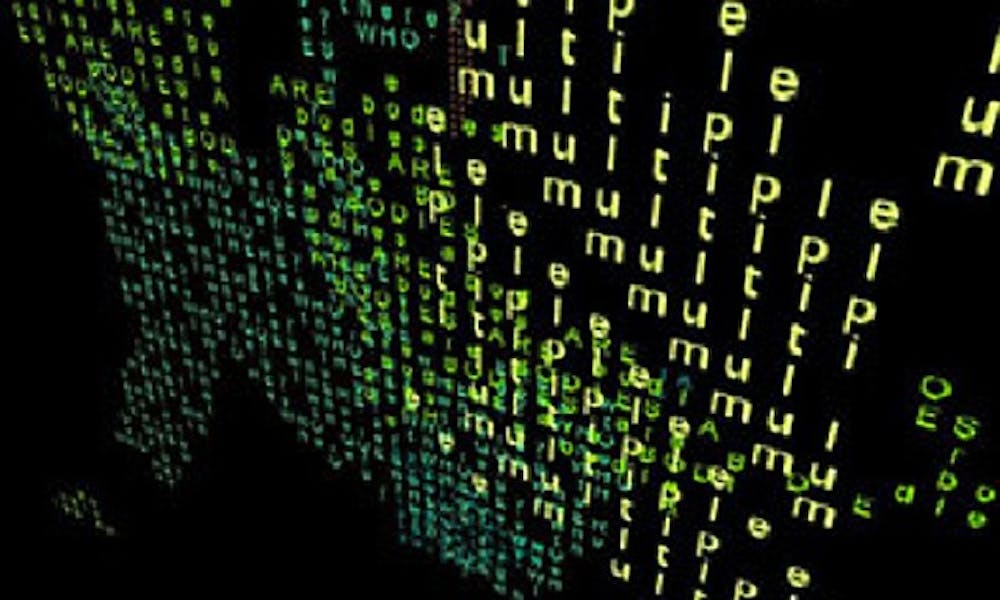In a way, CAM Raleigh (Contemporary Art Museum Raleigh) resembles a split-level house. An expansive top-floor exhibition space spills into connecting middle ground; beneath it are interconnected gallery rooms. Echoing this preoccupation with the creative potential of space and the ways in which physical properties interact, CAM’s two current exhibitions, Deep Surface: Contemporary Ornament and Pattern and ID:ENTITY: Self: Perception + Reality, challenge how we engage with art on a surface level. When we encounter unique sculptures, do we want to touch them? Can clothing take on meaning beyond wearability and aesthetic decoration? How do we construct our identity through the objects, physical and digital, that surround and engulf us?
Deep Surface addresses these questions up front. Entering the exhibition, you immediately see different manifestations of “ornament,” which the exhibition defends as a “communicative, functional and desirable form of cultural expression.” Wiry sculptures abut cases filled with tea china; large-scale photographs depict modern buildings designed like gaudy, multi-colored gingerbread houses. From the exhibition’s diverse media, you glean that the curators’ idea of “ornament” has an interdisciplinary leaning rather than rigid classification. Organized into six sections—“Amplification,” “Everyday,” “Kit-of-Parts,” “Inheritances,” “Elaboration” and “Fantasy”—Deep Surface plays with its own internal categorization as a way to re-think how art lives up to and simultaneously breaks down definitions and assumptions.
In one corner of the exhibition, a collection of pieces illustrates how art traditionally deemed “decorative” or “ornamental” transcends its derogatory connotations. Inscribed across an entire wall, the sentence, “Ornament is meant to be read” confronts viewers with its capitalization and large typeface. The work—by Dutch artist Hansje van Halem and called Doily Type—is most remarkable, however, for its embellished typeface. Each letter is made up of swirling patterns, and when considered from afar, the work seems equal parts Fabergé egg and magnified cell bacteria. The holistic result is both puzzling and powerful. Decorative form battles simple, directive content proposing that the art we typically discard as “ornamental” could, and should, require deeper intellectual engagement. There is more, so to speak, below the surface—or perhaps the surface itself is complex and beguiling.
Nearby is Clare Page and Harry Richardson’s tripartite sculptural piece Love (Blossoms). Made with Lladró porcelain figurine couples, the work lives up to its title: miniature glass flowers on the figurines’ faces inhibit physical embrace but make the piece more texturally dynamic. Page and Richardson point toward the same tension in van Halem’s piece—when does adornment or decoration become inhibitive for artistic meaning, and when does it actually enhance our ability to engage with art? Mario Minale and Kuniko Maeda’s Delfts Toast Pan & Plate further probes this question. At first glance, the work seems nothing more than a plate and toaster pan from your grandmother’s blue-and-white antique English pottery collection. Look closely, though, and you’ll notice a black print oozed onto the bread as if the aluminum leaf-and-flower pattern intended more than decoration. The toast’s branded pattern, traditional in form yet abstract in color, takes the piece out of its decorative context to propose something more unusual and atemporal.
ID:ENTITY: Self: Perception + Reality poses interesting questions related to the self and society. Conflating the impulsive-driven id with a non-specific “entity,” the exhibition features digital works that use audience participation to question digital identity and how our bodies respond to the internet. In Synchronous Objects, by Maria Palazzi and Norah Zuniga-Shaw in collaboration with experimental ballet choreographer William Forsythe, dancers move at breakneck speed atop, beneath and around several tables in a warehouse. Throughout the video, the screen goes black, reducing the dancers to multi-colored lines representing their movements and gesticulations. The piece flirts with formal simplicity even as it requires extremely developed methods of digital documentation, transforming our traditional conceptions of bodies moving in space. The piece ponders whether this is what our generation, so absorbed by the internet, will leave behind as well.
Some pieces in ID:ENTITY have a more political bent than those of Deep Surface, keeping the exhibition relevant through targeted commentary rather than solely digital experimentation. The Ladder, by Lee Cherry, Patrick FitzGerald, Daniel Lunk and James Martin, fuses video projection and pen drawing to mirror a pinball game with buzzwords like “job market” and “the 1%.” Via video, a ball hurtles through the maze, meeting its fate within these arbitrary categories. Beyond its socio-political resonance, the piece speaks to Deep Surface’s consideration of what lies beneath societal definitions and generalizations. Both exhibitions, while varied in artistic medium, take a closer look at how we inhabit our world—in a tactile and an intellectual sense—on perceived levels of depth and superficiality.
Get The Chronicle straight to your inbox
Sign up for our weekly newsletter. Cancel at any time.

